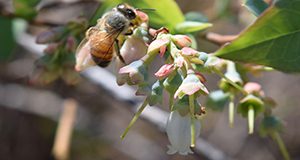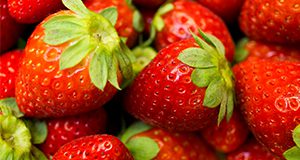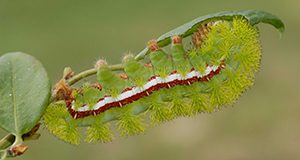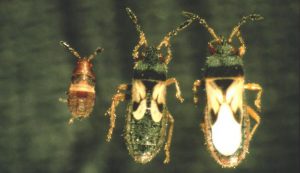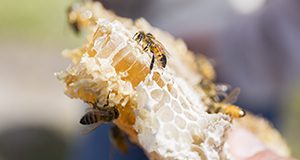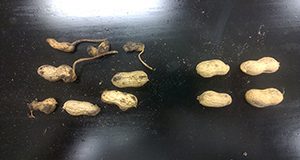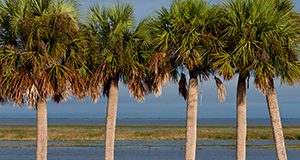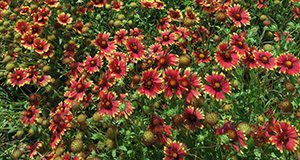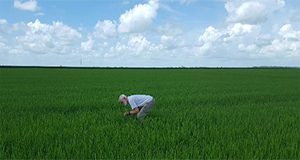The Caribbean fruit fly, Anastrepha suspensa, is a member of the fly family Tephritidae, which contains some of the most destructive fruit pests in the world. This 4-page fact sheet written by Amanda Coleen Hodges and Cory Penca and published by the UF/IFAS Department of Entomology and Nematology provides information about the biology and management of the Caribbean fruit fly.
http://edis.ifas.ufl.edu/in1242
Tag: Department of Entomology and Nematology
Blueberry Gall Midge on Southern Highbush Blueberry in Florida
Blueberry gall midge is a small fly native to North America that feeds on blueberries and cranberries. It can be found throughout the United States, including Florida, where its larvae feed on southern highbush blueberry and rabbiteye floral and vegetative buds. Reports of blueberry gall midge damage on southern highbush blueberry in Florida have become more common in recent years, in some cases significantly impacting yield where there was severe feeding damage to floral buds. This 3-page fact sheet written by Oscar Liburd and Doug Phillips and published by the UF/IFAS Department of Entomology and Nematology will inform growers how to scout for, identify, and control blueberry gall midge.
http://edis.ifas.ufl.edu/in1239
Pollination Best Practices in Southern Highbush Blueberry in Florida
Southern highbush blueberry is the primary blueberry species grown in Florida. It is dependent upon pollinating insects for adequate pollination and fruit. Some Florida growers have reported cases of low fruit set in recent years, in particular on the cultivars Meadowlark and Emerald, which may have been due in part to poor pollination. This 5-page fact sheet written by Rachel E. Mallinger and Douglas A. Phillips and published by the UF/IFAS Department of Entomology and Nematology will discuss blueberry pollinators, some causes of poor pollination, and current best practices to reduce the possibility of poor pollination of southern highbush blueberry.
http://edis.ifas.ufl.edu/in1237
The Southern Pine Beetle Dendroctonus frontalis (Coleoptera: Curculionidae: Scolytinae)
The southern pine beetle, Dendroctonus frontalis Zimmermann, is the most destructive insect pest of pine in the southern United States. This 8-page fact sheet written by Demian F. Gomez and Jiri Hulcr and published by the UF/IFAS Department of Entomology and Nematology describes the beetle and includes advice on how to monitor for them and strategies for their prevention and control.
http://edis.ifas.ufl.edu/in333
Meloidogyne Hapla, the Northern Root-Knot Nematode, in Florida Strawberries and Associated Double-Cropped Vegetables
Northern root-knot nematodes (Meloidogyne hapla) are rather uncommon nematode parasites of strawberries and vegetables in Florida, but when present they are capable of causing significant crop loss. Root-knot nematodes are largely unknown to strawberry growers in Florida and very little is known about their biology and behavior in the state. This 5-page fact sheet written by J. Desaeger and published by the UF/IFAS Department of Entomology and Nematology is intended to educate and provide information on this nematode to researchers, Extension agents, growers, industry representatives, and other stakeholders in the strawberry and vegetable community.
http://edis.ifas.ufl.edu/in1224
Nematodes Parasitizing Hops in Florida
The growth of Florida’s craft beer industry has created new opportunities for Florida growers to establish commercial hop (Humulus lupulus) operations. However, many challenges including several nematode species make the establishment of this industry difficult. This 4-page fact sheet written by Johan Desaeger and published by the UF/IFAS Department of Entomology and Nematology describes nematodes that prey on hops and suggests some strategies for preventing nematode damage to safeguard this emerging industry.
http://edis.ifas.ufl.edu/in1229
Florida Beekeeping Management Calendar
Climate, plant communities, and timing of floral resources differ significantly across Florida, which means that management of European honey bee colonies in Florida differs as well. This 8-page fact sheet written by James D. Ellis, Mary C. Bammer, and William H. Kern and published by Department of Entomology and Nematology outlines a management calendar created for Florida beekeepers. It is specific to region (north, central, and south Florida) and month and includes recommendations for major management considerations like when to treat for parasites or pathogens and when to feed colonies or harvest honey. This management calendar, while not exhaustive, is a valuable reference or starting point for honey bee colony management in Florida.
http://edis.ifas.ufl.edu/in848
Stinging and Venomous Caterpillars of the Southeast
Wasp and bee stings are familiar to most people, but some might be surprised to learn that several caterpillars can also sting. Unlike wasps and bees with stingers, these caterpillars have barbed hairs that break off the caterpillar when it brushes against something. The hairs embed in skin and cause sudden or gradually building pain. The severity of a caterpillar sting varies based on the person and number of spines in the skin. Many stinging caterpillars also release a toxin on contact, which may cause health problems for some people. This 4-page fact sheet written by Rebecca Perry and Adam Dale and published by the UF/IFAS Department of Entomology and Nematology describes several stinging caterpillars commonly found throughout the southeastern United States.
https://edis.ifas.ufl.edu/in014
Managing Southern Chinch Bug in Warm Season Turfgrasses
Southern chinch bug, Blissus insularis Barber, is the most damaging insect pest of St. Augustinegrass in the United States. St. Augustinegrass is the most common turfgrass used in Florida. The ubiquity of this single turfgrass species makes southern chinch bug an economically important pest in the state. In fact, chinch bugs cost Florida homeowners and professionals millions of dollars every year. This 7-page fact sheet written by Eileen A. Buss, Brianna M. Whitman, and Adam G. Dale and published by the UF/IFAS Department of Entomology and Nematology describes the biology of the pest and the damage it causes and lists ways to scout and monitor for chinch bugs and some strategies for control of the pest.
http://edis.ifas.ufl.edu/lh036
Wax Moth Control
The greater wax moth (Galleria mellonella Linnaeus) and lesser wax moth (Achroia grisella Fabricius) are major pests of honey bee colonies in Florida. The best defense against wax moths in living colonies is keeping colonies otherwise strong, free of diseases and pests, and queenright. Controlling wax moths in stored combs and equipment, however, can be more difficult. This 3-page fact sheet written by Cameron J. Jack and Jamie D. Ellis and published by the UF/IFAS Department of Entomology and Nematology details the steps beekeepers can take to control wax moths and keep them from ruining stored honey bee combs and equipment.
http://edis.ifas.ufl.edu/aa141
Dimorphic Jumper Maevia inclemens (Walckenaer 1837) (Arachnida: Araneae: Salticidae)
Maevia inclemens is a common jumping spider found in vines and ivy along tree lines throughout eastern North America. Learn about this interesting and possibly agriculturally beneficial spider in this 3-page fact sheet written by Laurel Lietzenmayer and Lisa Taylor and published by the UF/IFAS Department of Entomology and Nematology.
http://edis.ifas.ufl.edu/in1209
Dark Southern Drywood Termite (suggested common name) Kalotermes approximatus Snyder (Insecta: Isoptera: Kalotermitidae)
Dark southern drywood termites are classified as “an uncommon structural pest,” though some infestations have been recorded. Learn to identify this termite species and get information about its distribution, history, biology, and management in this 5-page fact sheet written by Joseph F. Velenovsky and Rudolf H. Scheffrahn and published by the UF/IFAS Department of Entomology and Nematology.
http://edis.ifas.ufl.edu/in1208
Living with the African Honey Bee
African honey bees and European honey bees are the same species of honey bee, but the two are classified as different subspecies or races of honey bee. African honey bee x European honey bee hybrids present an unpredictable combination of both subspecies‹ behavioral traits. This 4-page fact sheet written by J. D. Ellis and M. Bammer and published by the UF/IFAS Department of Entomology and Nematology explains how to “bee-proof” your house and yard and develop a bee safety plan as well as what you can do if you encounter a swarm or a colony of bees and how to treat a bee sting.
edis.ifas.ufl.edu/in1205
Swimmer's Itch (Cercarial Dermatitis)
Learn how to swim safely and avoid this itchy skin rash in this 3-page document written by Emma N. I. Weeks and Katherine Sayler and published by the UF/IFAS Department of Entomology and Nematology.
http://edis.ifas.ufl.edu/in1200
Management of Plant-Parasitic Nematodes in Florida Peanut Production
Nematodes, non-segmented roundworms, can cause serious yield suppression in peanut production. This 10-page fact sheet written by Zane J. Grabau and Donald W. Dickson and published by the UF/IFAS Department of Entomology and Nematology explains how to recognize a potential nematode problem in a peanut production, confirm it with an expert, and choose the best management tools to control the problem.
http://edis.ifas.ufl.edu/in1199
Sampling Palms for Lethal Yellowing and Texas Phoenix Palm Decline Phytoplasmas
In Florida, palms are an economically important group of trees in the nursery and landscaping industries. Phytoplasma diseases of palms are a major concern because they infect a wide variety of these valuable ornamental palms, and they are lethal. Once symptoms appear, trees begin to decline, frequently rapidly, and can die in as few as 3 to 5 months. This 4-page fact sheet written by Brian W. Bahder and Ericka E. Helmick and published by the UF/IFAS Department of Entomology and Nematology describes how to sample palms for disease and how to submit samples to the Vector Entomology Lab. Includes a table listing equipment and supplies and protocol for sampling palm trunk tissue.
http://edis.ifas.ufl.edu/in1197
Foliar or Bud Nematodes in Florida Strawberries
Foliar or bud nematodes are little-known nematodes that caused “crimp disease” in Florida strawberries in the early 1900s. Recently, these foliar nematodes have been observed again in the state, and seem to have come in with transplants from outside Florida. Foliar/bud nematodes can devastate a crop of strawberries. Plants become stunted with curled up leaves, and produce few or no flowers or fruits. This 7-page fact sheet written by J. Desaeger and J. Noling and published by the UF/IFAS Department of Entomology and Nematology provides much-needed information on these little-understood pests, summarizing the different types of foliar nematodes, their biology, life cycle, damage symptoms, survival strategies, dissemination, and management options.
edis.ifas.ufl.edu/in1184
Impervious Surface Thresholds and the Pace to Plant Technique for Planting Urban Red Maple Trees
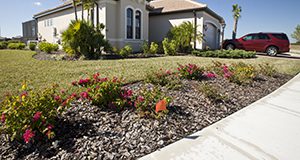
A foundation of integrated pest management (IPM) in urban landscapes is to put the right plant in the right place. This preventive tactic can reduce plant stress, pest infestations, and subsequent pesticide applications. Many urban tree species have more insect and mite pests in urban landscapes than in surrounding natural areas. This is due in part to stress created by impervious surfaces like roads and sidewalks that make the air hot and the soil dry. For red maples (Acer rubrum), more impervious surface area adds stress and worsens tree condition. This 4-page publication written by Adam G. Dale, Steven D. Frank, Elsa Youngsteadt, Barbara Fair, Julieta Sherk, and Michael Just and published by the UF/IFAS Department of Entomology and Nematology focuses on selecting red maple planting sites that will help reduce tree stress and scale insect pests by maximizing surfaces permeable to water.
http://edis.ifas.ufl.edu/in1185
A Guide to Planting Wildflower Enhancements in Florida
The establishment of native wildflower plantings in Florida can benefit agricultural producers as well as native pollinators and other beneficial insects. Wildflowers provide forage and nesting sites for bees, butterflies, and other pollinators, increasing wild bee numbers across the farm, and increasing natural enemies of insect pests. This 6-page fact sheet written by Mary C. Bammer, Josh Campbell, Chase B. Kimmel, James D. Ellis, and Jaret Daniels and published by the UF/IFAS Department of Entomology and Nematology discusses choosing the right mix of native plant species to benefit many pollinator species, as well as proper site selection, planting practices, and weed control techniques. Wildflower plots are practical to manage, maximize benefits to wildlife, and fit well into overall agricultural operation management practices.
http://edis.ifas.ufl.edu/in1180
Rice Water Weevil (Coleoptera: Curculionidae) Distribution and Management in Florida
The rice water weevil, Lissorhoptrus oryzophilus Kuschel, is the most widely distributed and destructive pest of rice in the United States. This 4-page fact sheet written by Matthew T. VanWeelden and Ron Cherry and published by the Department of Entomology and Nematology provides a description of the rice water weevil, its distribution in the state of Florida, methodology for scouting, and options for managing this pest in commercial rice fields.
http://edis.ifas.ufl.edu/in1167


